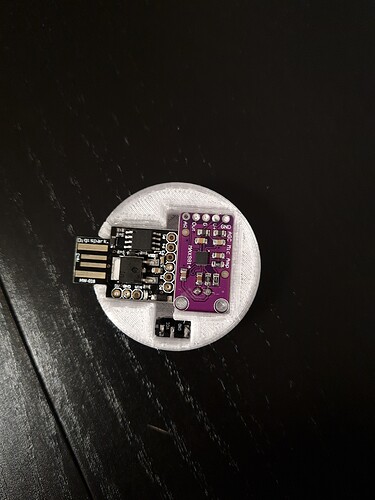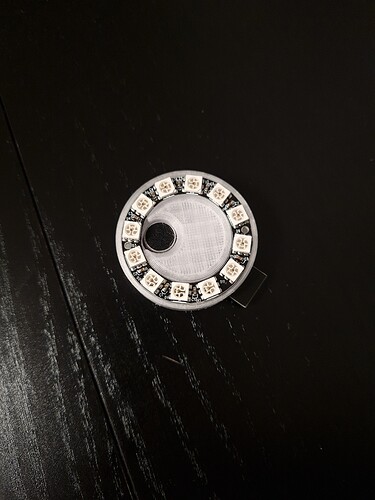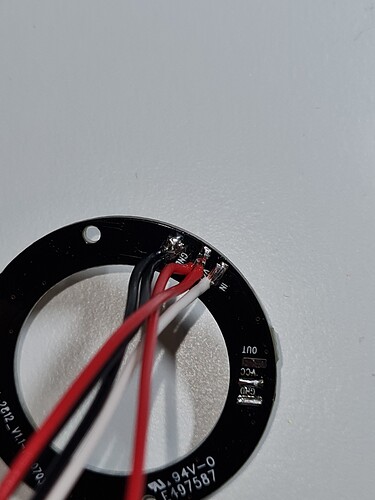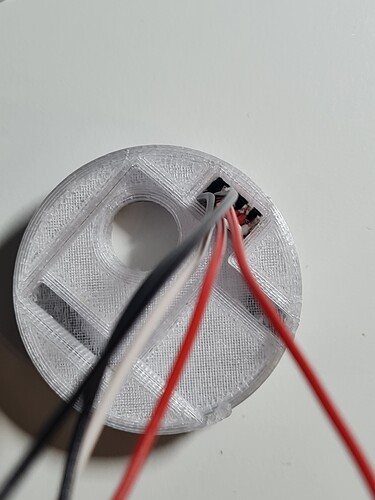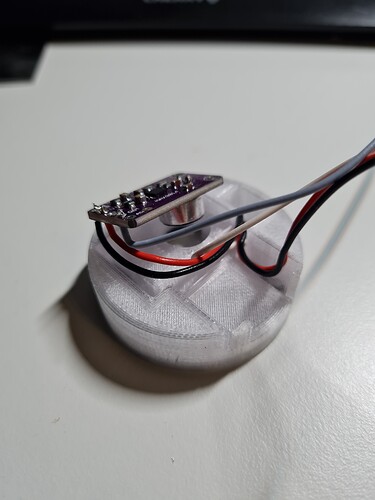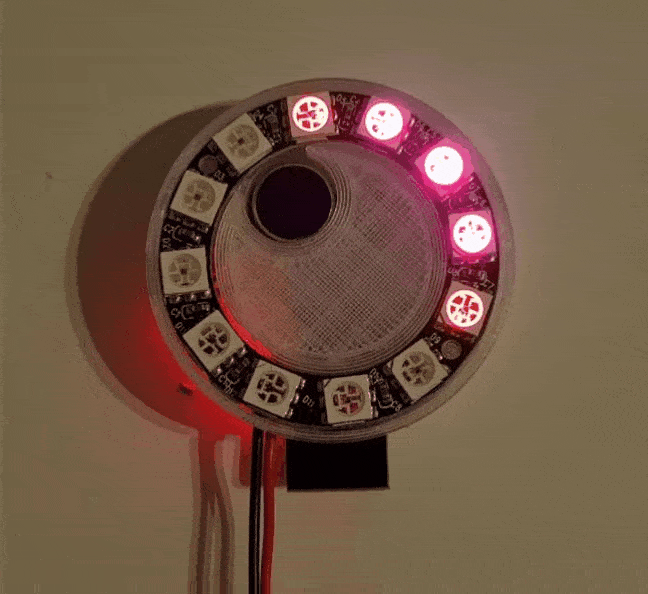Ich hab einen bessern Code gefunden, der mir sehr gut gefällt.
Mehr Farben, bessere übergänge, schönere Animation.
Der Attiny lässt leider nicht all zu viel zu.
https://learn.sparkfun.com/tutorials/interactive-led-music-visualizer/all
Hier unter dem Punkt: „Simple Visualizer Program“ ist ein Testcode. Dieser passt fast genau auf den tiny.
Ein paar Anpassungen müssen aber vorgenommen werden. Der komplette Code dort enthält auch weiter Animationen und Farbsets. Eventuell lassen sich dies im Testcode Ersatzweise einfügen. Hier der Code mit meinen Anpassungen:
//language:c
//Program by Michael Bartlett
//https://learn.sparkfun.com/tutorials/interactive-led-music-visualizer/all
//Libraries
#include <Adafruit_NeoPixel.h> //Library to simplify interacting with the LED strand
#ifdef __AVR__
#include <avr/power.h> //Includes the library for power reduction registers if your chip supports them.
#endif //More info: http://www.nongnu.org/avr-libc/user-manual/group__avr__power.htlm
//Constants (change these as necessary)
#define LED_PIN 0 //Pin for the pixel strand. Does not have to be analog.
#define LED_TOTAL 12 //Change this to the number of LEDs in your strand.
#define LED_HALF LED_TOTAL/2
#define AUDIO_PIN A1 //Pin for the envelope of the sound detector
//#define KNOB_PIN A1 //Pin for the trimpot 10K
#define INTERNAL2V56_NO_CAP (6)
//////////<Globals>
// These values either need to be remembered from the last pass of loop() or
// need to be accessed by several functions in one pass, so they need to be global.
Adafruit_NeoPixel strand = Adafruit_NeoPixel(LED_TOTAL, LED_PIN, NEO_GRB + NEO_KHZ800); //LED strand objetc
uint16_t gradient = 0; //Used to iterate and loop through each color palette gradually
uint8_t volume = 0; //Holds the volume level read from the sound detector.
uint8_t last = 0; //Holds the value of volume from the previous loop() pass.
float maxVol = 15; //Holds the largest volume recorded thus far to proportionally adjust the visual's responsiveness.
float knob = 1023.0; //Holds the percentage of how twisted the trimpot is. Used for adjusting the max brightness.
float avgVol = 0; //Holds the "average" volume-level to proportionally adjust the visual experience.
float avgBump = 0; //Holds the "average" volume-change to trigger a "bump."
bool bump = false; //Used to pass if there was a "bump" in volume
//////////</Globals>
//////////<Standard Functions>
void setup() { //Like it's named, this gets ran before any other function.
//Serial.begin(9600); //Sets data rate for serial data transmission.
strand.begin(); //Initialize the LED strand object.
strand.show(); //Show a blank strand, just to get the LED's ready for use.
}
void loop() { //This is where the magic happens. This loop produces each frame of the visual.
analogReference( INTERNAL2V56_NO_CAP );
volume = analogRead(AUDIO_PIN); //Record the volume level from the sound detector
//knob = 0.8; //Record how far the trimpot is twisted
avgVol = (avgVol + volume) / 2.0; //Take our "average" of volumes.
//Sets a threshold for volume.
// In practice I've found noise can get up to 15, so if it's lower, the visual thinks it's silent.
// Also if the volume is less than average volume / 2 (essentially an average with 0), it's considered silent.
if (volume < avgVol / 2.0 || volume < 15) volume = 0;
//If the current volume is larger than the loudest value recorded, overwrite
if (volume > maxVol) maxVol = volume;
//This is where "gradient" is reset to prevent overflow.
if (gradient > 1529) {
gradient %= 1530;
//Everytime a palette gets completed is a good time to readjust "maxVol," just in case
// the song gets quieter; we also don't want to lose brightness intensity permanently
// because of one stray loud sound.
maxVol = (maxVol + volume) / 2.0;
}
//If there is a decent change in volume since the last pass, average it into "avgBump"
if (volume - last > avgVol - last && avgVol - last > 0) avgBump = (avgBump + (volume - last)) / 2.0;
//if there is a notable change in volume, trigger a "bump"
bump = (volume - last) > avgBump;
Pulse(); //Calls the visual to be displayed with the globals as they are.
gradient++; //Increments gradient
last = volume; //Records current volume for next pass
delay(50); //Paces visuals so they aren't too fast to be enjoyable
}
//////////</Standard Functions>
//////////<Helper Functions>
//PULSE
//Pulse from center of the strand
void Pulse() {
fade(0.75); //Listed below, this function simply dims the colors a little bit each pass of loop()
//Advances the gradient to the next noticeable color if there is a "bump"
if (bump) gradient += 64;
//If it's silent, we want the fade effect to take over, hence this if-statement
if (volume > 0) {
uint32_t col = Rainbow(gradient); //Our retrieved 32-bit color
//These variables determine where to start and end the pulse since it starts from the middle of the strand.
// The quantities are stored in variables so they only have to be computed once.
int start = LED_HALF - (LED_HALF * (volume / maxVol));
int finish = LED_HALF + (LED_HALF * (volume / maxVol)) + strand.numPixels() % 2;
//Listed above, LED_HALF is simply half the number of LEDs on your strand. ↑ this part adjusts for an odd quantity.
for (int i = start; i < finish; i++) {
//"damp" creates the fade effect of being dimmer the farther the pixel is from the center of the strand.
// It returns a value between 0 and 1 that peaks at 1 at the center of the strand and 0 at the ends.
float damp = float(
((finish - start) / 2.0) -
abs((i - start) - ((finish - start) / 2.0))
)
/ float((finish - start) / 2.0);
//Sets the each pixel on the strand to the appropriate color and intensity
// strand.Color() takes 3 values between 0 & 255, and returns a 32-bit integer.
// Notice "knob" affecting the brightness, as in the rest of the visuals.
// Also notice split() being used to get the red, green, and blue values.
strand.setPixelColor(i, strand.Color(
split(col, 0) * pow(damp, 2.0) * knob,
split(col, 1) * pow(damp, 2.0) * knob,
split(col, 2) * pow(damp, 2.0) * knob
));
}
//Sets the max brightness of all LEDs. If it's loud, it's brighter.
// "knob" was not used here because it occasionally caused minor errors in color display.
strand.setBrightness(255.0 * pow(volume / maxVol, 2));
}
//This command actually shows the lights. If you make a new visualization, don't forget this!
strand.show();
}
//Fades lights by multiplying them by a value between 0 and 1 each pass of loop().
void fade(float damper) {
//"damper" must be between 0 and 1, or else you'll end up brightening the lights or doing nothing.
if (damper >= 1) damper = 0.99;
for (int i = 0; i < strand.numPixels(); i++) {
//Retrieve the color at the current position.
uint32_t col = (strand.getPixelColor(i)) ? strand.getPixelColor(i) : strand.Color(0, 0, 0);
//If it's black, you can't fade that any further.
if (col == 0) continue;
float colors[3]; //Array of the three RGB values
//Multiply each value by "damper"
for (int j = 0; j < 3; j++) colors[j] = split(col, j) * damper;
//Set the dampened colors back to their spot.
strand.setPixelColor(i, strand.Color(colors[0] , colors[1], colors[2]));
}
}
uint8_t split(uint32_t color, uint8_t i ) {
//0 = Red, 1 = Green, 2 = Blue
if (i == 0) return color >> 16;
if (i == 1) return color >> 8;
if (i == 2) return color >> 0;
return -1;
}
//This function simply take a value and returns a gradient color
// in the form of an unsigned 32-bit integer
//The gradient returns a different, changing color for each multiple of 255
// This is because the max value of any of the 3 LEDs is 255, so it's
// an intuitive cutoff for the next color to start appearing.
// Gradients should also loop back to their starting color so there's no jumps in color.
uint32_t Rainbow(unsigned int i) {
if (i > 1529) return Rainbow(i % 1530);
if (i > 1274) return strand.Color(255, 0, 255 - (i % 255)); //violet -> red
if (i > 1019) return strand.Color((i % 255), 0, 255); //blue -> violet
if (i > 764) return strand.Color(0, 255 - (i % 255), 255); //aqua -> blue
if (i > 509) return strand.Color(0, 255, (i % 255)); //green -> aqua
if (i > 255) return strand.Color(255 - (i % 255), 255, 0); //yellow -> green
return strand.Color(255, i, 0); //red -> yellow
}
//////////</Helper Functions>
Ich habe auch eine erste Aufnahme für alle Komponenten „konstruiert“. Mal sehen ob das klappt
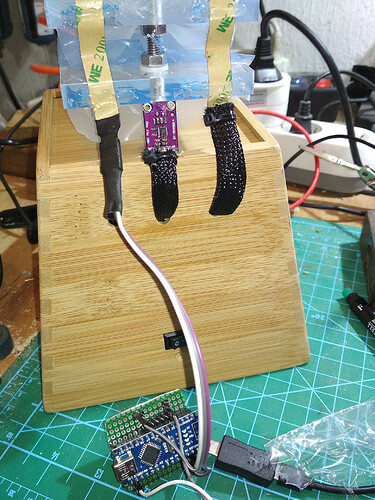
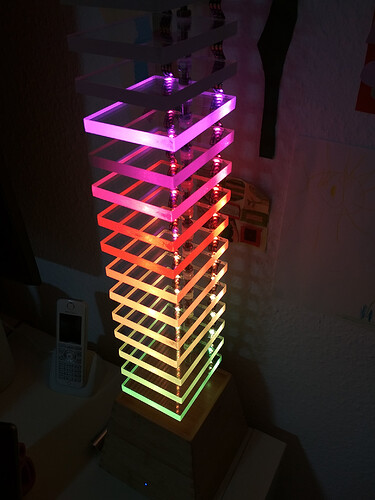


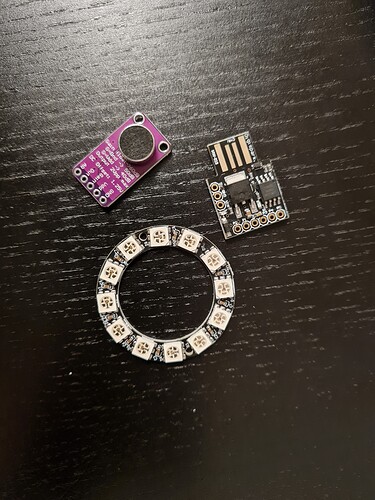
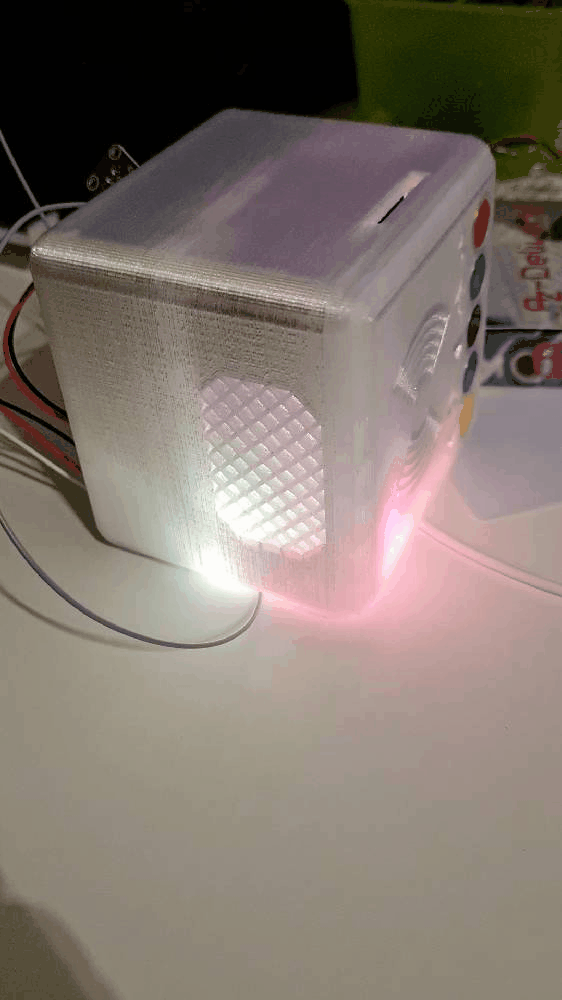
 ).
).